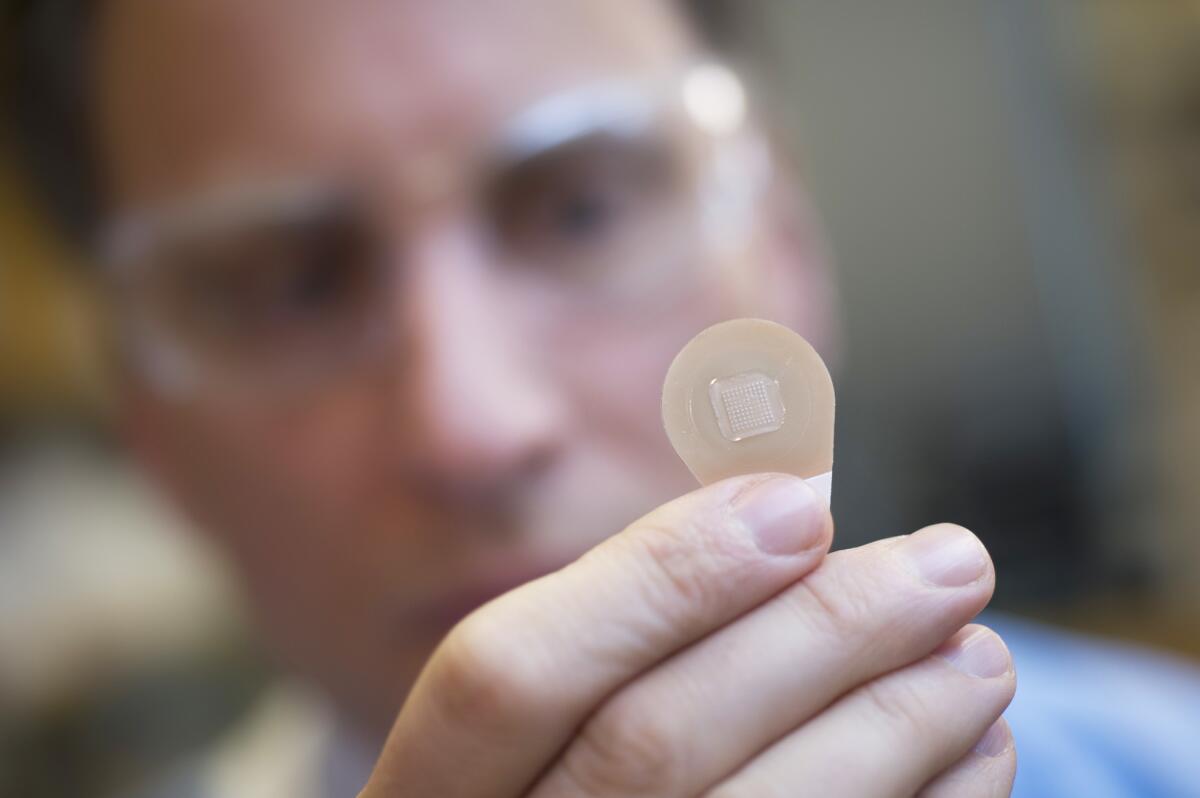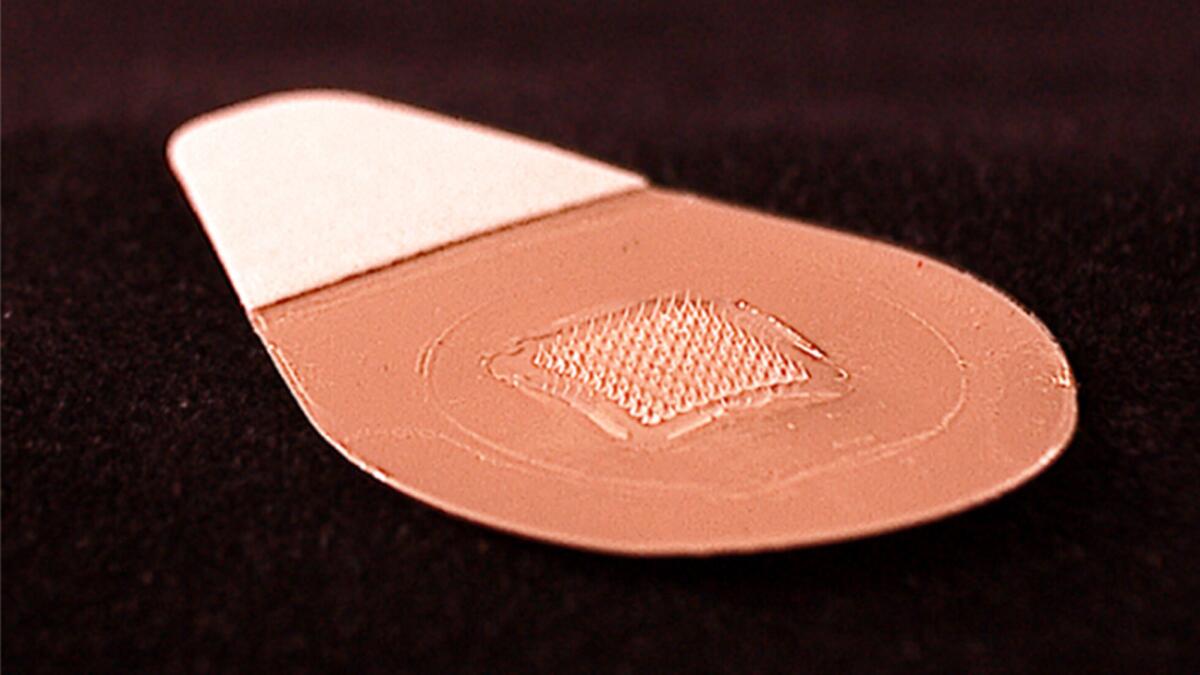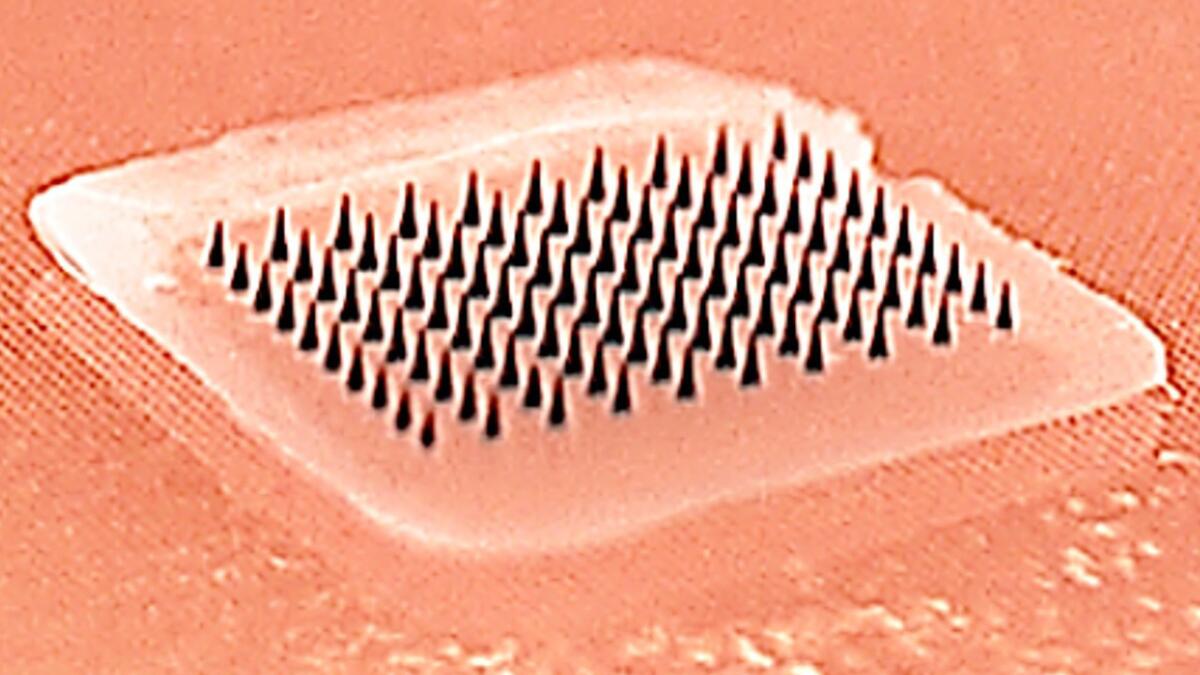This cutting-edge bandage could make flu shots a thing of the past

Researchers have developed a dissolvable microneedle patch that regular folks can use to give themselves a flu shot. (June 28, 2017) (Sign up for our free video newsletter here http://bit.ly/2n6VKPR)
- Share via
Here’s an idea whose time has come: A
For the first time, researchers have tested a flu vaccine patch in a human clinical trial and found that it delivered as much protection as a traditional jab with a needle.
It’s not just needle-phobes who stand to benefit from this development, reported Tuesday in the journal Lancet. Doctors and public health experts have high hopes that vaccine patches will boost the number of people who get immunized against the flu.
Seasonal influenza is responsible for up to half a million deaths around the world each year, according to the World Health Organization. In the United States, the annual death toll since 2010 has ranged between 12,000 and 56,000. And yet the proportion of American adults who get a flu shot tends to hover around 40%.
The fact that it usually involves poking a piece of metal into the muscle of your upper arm may have something to do with that low vaccination rate. (Some people also blame the time and expense involved in getting a flu shot.)
But a team led by Georgia Tech engineer Mark Prausnitz has come up with an alternative method that uses “microneedles.” These tiny needles are so small that 100 of them, arrayed on a patch, can fit under your thumb. Yet they’re big enough to hold vaccine for three strains of the flu.

The microneedle patch was tested in a clinical trial conducted by Dr. Nadine Rouphael and colleagues at Emory University’s Hope Clinic in Decatur, Ga. The trial involved 100 volunteers, who were randomly sorted into four groups.
Two of the groups were vaccinated with the patch, which resembles a Band-Aid and must be applied to the skin near the wrist for 20 minutes. The procedure was so straightforward that one group of volunteers was able to administer the vaccine themselves. (In the other group, healthcare professionals did the job.) Inspection of the used vaccine patches revealed that the microneedles dissolved during the 20 minutes they were on the skin.

A third group received a traditional flu shot using a regular needle, and a fourth group got a patch that looked like the real thing but contained a placebo.
The researchers checked in on the volunteers 28 days after their immunizations and found that flu antibody levels were “significantly higher” in the three groups that got the vaccine than in the group that got the placebo.
What’s more, the two groups that got the vaccine via a patch had about the same antibody levels as the group that got the traditional shot. In addition, the volunteers who put the patches on themselves got the same protection as the volunteers whose patches were administered by health professionals.
After six months, at least 75% of volunteers in all three vaccine groups were still being protected, according to the study.
The traditional shot contained at least 15 micrograms of antigens (the part of the flu virus that triggers an immune response) to each of the three strains of flu. The patches delivered a slightly smaller dose of antigens, regardless of whether the patch was deployed by a health professional or a volunteer.

None of the study volunteers had serious side effects. The groups that got patches had mild skin reactions that were not seen in the regular needle group, while the volunteers in the regular needle group were more likely to experience pain.
Overall, 70% of the volunteers who got vaccine patches said they’d rather use them again than get a traditional flu shot or an intranasal vaccine. The study authors declared it a success on all fronts.
“Influenza vaccination with microneedle patches is well tolerated, well accepted, and results in robust immunological responses, whether administered by health-care workers or by the participants themselves,” they wrote.
Still, they added that the patches would have to perform well in larger studies before they could be put into wide use. Ideally, future versions of the patches would produce fewer skin reactions while delivering the same protection, they wrote.
Their enthusiasm was echoed in a commentary that accompanied the study.
“These early findings suggest the emergence of a promising new option for seasonal vaccination,” wrote Katja Hoschler and Maria Zambon of Public Health England.
The biggest beneficiaries could be people in low- and middle-income countries, where flu vaccines are hard to come by. Reducing pain is nice, but other benefits — the patch costs less, is easier to transport, doesn’t require refrigeration, can be self-administered and doesn’t generate sharps waste — are even better.
“Microneedle patches have the potential to become ideal candidates for vaccination programs,” they wrote.
Follow me on Twitter @LATkarenkaplan and "like" Los Angeles Times Science & Health on Facebook.
MORE IN SCIENCE
Why the next flu medicine could come from frog mucus
To preserve mental acuity into old age, experts suggest focusing on these three things
How oxygen-producing pond scum could save your life after a heart attack
As lawmakers debate GOP healthcare bill, new study finds stripping people of insurance can be deadly
How a fear of humans affects the lives of California's mountain lions




